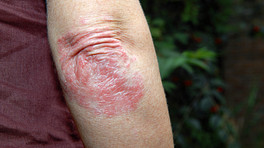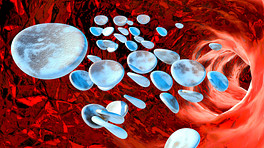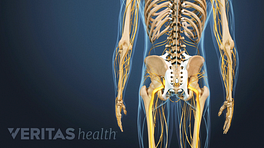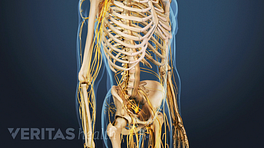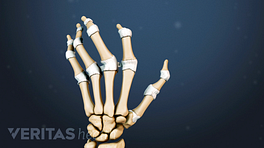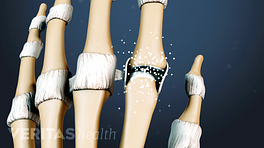Aptly named, reactive arthritis is arthritis that develops as a reaction to an infection, such as a stomach bug or a sexually transmitted disease (STD). Days, weeks, or even months after an infection, a person may develop pain in one or more joints, inflamed eyes, and/or other reactive arthritis symptoms.
In This Article:
6 Fundamental Facts about Reactive Arthritis
The facts listed below provide insights into what reactive arthritis is, how it develops, and how it is treated.
1. Reactive arthritis is not a symptom of an infection
Joint pain and other reactive arthritis symptoms are not a direct result of the original infection. Symptoms often begin 2 to 4 weeks after the initial infection is gone, though this timeline varies greatly from person to person—some experts believe the initial infection may occur a year or more before reactive arthritis symptoms appear. 1 Ajene AN, Walker CLF, Black RE. Enteric Pathogens and Reactive Arthritis: A Systematic Review of Campylobacter, Salmonella and Shigella-associated Reactive Arthritis. Journal of Health, Population, and Nutrition. 2013;31(3):299-307.
2. It is not clear how reactive arthritis develops
Doctors know that certain infections are more likely to trigger reactive arthritis, and that people who carry the gene HLA-B27 are more likely to get it, but they are still researching exactly how reactive arthritis develops.
Current hypotheses describe a series of events that occur between the original bacterial infection, a person’s genes, and his or her immune system. Some hypotheses also consider bacteria in the gut 2 Schmitt SK. Reactive Arthritis. Infect Dis Clin North Am. 2017;31(2):265-277. , 3 Asquith M, Rosenbaum JT. The interaction between host genetics and the micro- biome in the pathogenesis of spondyloarthropathies. Curr Opin Rheumatol 2016; 28(4):405–12. called the gut microbiome.
3. Reactive arthritis is not contagious
This inflammatory arthritis is not transmitted from person to person. However, the bacteria that caused the infection can be transmitted. For example, a person infected with chlamydia who develops reactive arthritis may transmit chlamydia but not arthritis. Once an infection has been successfully treated (or resolves on its own) it cannot be spread, even if reactive arthritis symptoms remain present.
4. Reactive arthritis usually goes away
Most people who get reactive arthritis return to normal in less than a year—in fact, 50% of people experience symptoms for 6 months or less. 2 Schmitt SK. Reactive Arthritis. Infect Dis Clin North Am. 2017;31(2):265-277. These cases may require medical care or may just warrant monitoring by doctors. Either way, these cases usually resolve on their own.
About 25% of people have symptoms that last beyond one year. 4 Hannu T, Inman R, GranforsK, et al. Reactive arthritis or post-infectious arthritis? Best Pract Res Clin Rheumatol 2006;20(3):419-33. These people are said to have chronic reactive arthritis or chronic spondyloarthritis, and they may require long-term treatment.
5. Reactive arthritis is part of group of diseases called spondyloarthritis
Medical professionals coined the umbrella term spondyloarthritis (pronounced spawn-dee-LOW-arth-RI-tis, also known as SpA) in the 1970s to describe several related diseases, including but not limited to ankylosing spondylitis, psoriatic arthritis, and reactive arthritis. 5 Rudwaleit M, van der Heijde D, Landewé R, et al. The development of Assessment of SpondyloArthritis international Society classification criteria for axial spondyloarthritis (part II): validation and final selection. Ann Rheum Dis 2009;68:777-83.
Spondyloarthritis conditions have many symptoms in common. They typically affect the spine—though any joint can be affected—and frequently also cause symptoms in the eyes, skin, and gastrointestinal system. Reactive arthritis accounts for just 1% to 2% of all spondyloarthritis cases.
6. Reactive arthritis used to be called Reiter’s Syndrome
The terms reactive arthritis and Reiter’s syndrome used to be interchangeable. Now, experts consider Reiter’s syndrome to be a type of reactive arthritis.
Reiter’s syndrome has three hallmark symptoms:
- Arthritis
- Conjunctivitis (pink eye)
- Inflammation of the urethra, the narrow tube that carries urine from the bladder to outside the body. This condition is called urethritis and it is often caused by an infection.
Doctors learning about Reiter’s syndrome are often taught the rhyme “Can’t see, can’t pee, can’t climb a tree.”
Patients who experience joint pain, swollen fingers or toes, problems urinating, and/or eye inflammation are encouraged to see their doctors and report any infections they have experienced in the last 6 months. If a doctor suspects a patient has reactive arthritis, he or she may try to identify the bacteria that caused the infection. Certain infections are closely associated with reactive arthritis.
- 1 Ajene AN, Walker CLF, Black RE. Enteric Pathogens and Reactive Arthritis: A Systematic Review of Campylobacter, Salmonella and Shigella-associated Reactive Arthritis. Journal of Health, Population, and Nutrition. 2013;31(3):299-307.
- 2 Schmitt SK. Reactive Arthritis. Infect Dis Clin North Am. 2017;31(2):265-277.
- 3 Asquith M, Rosenbaum JT. The interaction between host genetics and the micro- biome in the pathogenesis of spondyloarthropathies. Curr Opin Rheumatol 2016; 28(4):405–12.
- 4 Hannu T, Inman R, GranforsK, et al. Reactive arthritis or post-infectious arthritis? Best Pract Res Clin Rheumatol 2006;20(3):419-33.
- 5 Rudwaleit M, van der Heijde D, Landewé R, et al. The development of Assessment of SpondyloArthritis international Society classification criteria for axial spondyloarthritis (part II): validation and final selection. Ann Rheum Dis 2009;68:777-83.


